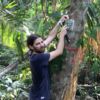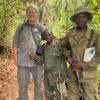ChatGPT for conservation
16 January 2023 10:04am
2 May 2024 4:56pm
This is so interesting - I would love to chat more about this as I've been thinking about this a lot for how we could (or shouldnt) be thinking about incorporating this into WILDLABS. Do you want to come on the Variety Hour and share more about you've been on this front at conservation evidence? Next call is on the 29th May!
2 May 2024 9:39pm
In my experience, ChatGPT-4 performs significantly better than version 3.5, especially in terms of contextual understanding. However, like any AI model, inaccuracies cannot be completely eliminated. I've also seen a video showing that Gemini appears to excel at literature reviews, though I haven't personally tested it yet. Here's the link to the video: https://www.youtube.com/watch?v=sPiOP_CB54A.
Welcome to WILDLABS!
29 October 2015 5:16pm
2 May 2024 2:50pm
Hello!
I am a Conservation Programs Manager for Assiniboine Park Conservancy (Winnipeg, MB, Canada) focused mostly on Arctic and Northern species. My main expertise is in the world of biologging for marine mammals, but I also work with other techniques like camera trapping, photogrammetry, drones, and more! I also support other conservation projects related to critically endangered grassland species, facilitating conservation planning, and supporting Indigenous and community-led research.
I've been on this site for a number of years, but realized I never introduced myself to this amazing community!
Courtney
2 May 2024 9:15pm
Hello Wildlabs community!
I’m excited to be here and introduce myself. I work for the Wildlife Conservation Society (WCS) in Argentina and have recently joined the Wildlabs team. I’m a biologist with a strong interest in bioacoustics and conservation. I've studied cetaceans in Argentina and Antarctica, using passive acoustic tools and visual methods to monitor these populations. My PhD focused on the acoustic behavior of Commerson’s dolphins and the impact of vessel noise in Patagonia, Argentina.
My current role involves conducting a global horizon scan on bioacoustics, aiming to assess the current state of bioacoustics and identify gaps, challenges, and priorities to advance the field, with a long-term vision.
I’m also part of the GIAS Research Group at the Universidad Nacional de Tres de Febrero, which aims to develop software and hardware to facilitate bioacoustic research projects in Argentina. Additionally, I teach at this university, offering a seminar on underwater acoustics to sound engineering students to spark their interest in bioacoustics and wildlife conservation. I’m thrilled to be part of this community and look forward to contributing and learning with all of you!
2 May 2024 9:28pm
Hi Simon,
great to have you here at Wildlabs.
I´m a big Deepfaune fan!
Greetings from the Austrian wild boar paradise,
Robin
Your HydroMoth experience!
29 July 2022 1:38pm
1 May 2024 5:45pm
Vinegar is also a great solution! Let it sit overnight and then just scrub it off. As a warning if you don't clean it, your sensitivity does decrease. You might actually see this if you keep it out there for a month that the amplitude of your calls decrease over the month/you might detect fewer calls.
1 May 2024 5:51pm
Hey! I would recommend a few things:
1) set up at least two in the same site kind of back to back or side to side if you have that many. Directionality can influence the number of calls you get and it's just good to know your error rate.
2) Experiment with breaks and recording duration. You wont collect anything if the write time is not long enough to record to your SD card and you'll get empty files.
3) Clean your device every time you take it out or see visible biofouling. Also, add silicon grease every time to your O-ring. Take it out with an O-ring pick and clean the plastic seal, looking for any type of sand/mud/debris. We've had a few flooding incidences, but this is probably because we open them all the time.
4) lower the frequency rate the more data you can collect, so keep it as low as your frequency of interest without clipping your calls. Fish are lower than pretty much everything (2kHz-3kHz).
I hope this helps!
2 May 2024 6:45pm
Oh wow, thank you so much!!!
I will keep that four advices in mind!
WILDLABS AWARDS 2024 - Developing AudioMoth for the detection of infrasonic elephant rumbles
11 April 2024 7:35am
11 April 2024 4:05pm
Awesome project!!
2 May 2024 6:24pm
Very interesting project! I had a few questions or things to consider. Funny enough, I work next to the Elephant Listening Project (ELP) in Central Africa. They've tried a few things to capture infrasonic sounds from these guys like with geophones, mics, and hydrophones, but while successful in Savannah elephant species, the dense forest and ground structure in Central Africa from my understanding increases the acoustic impedance and presented a challenge. Besides ground type, I'm also curious if there are differences in infrasonic vocalizations of Asian versus Central African elephants to consider? I think they'd be a great group to collaborate with, if you haven't reached out already!
The other question I had is if you're thinking of hardening the case? From what I've seen, elephants will break/play anything they find new. The acoustic swift team had to make a custom case for them so the elephants have a "less" likely chance of breaking them. Below is an example of a tusk versus a Pelican we keep around.

Insect cameras in The Inventory
1 May 2024 9:26pm
2 May 2024 9:20am
Adding all the insect cameras to The Inventory would be amazing!! (bonus points for also adding photos or reviews).
I've made sure you four have unlocked Inventory contributing powers. The user guide should cover how to do everything, but let me know if anyone has any questions at all!
2 May 2024 2:02pm
Hey @JakeBurton , nice work with The Inventory!
This is very aligned with some internal efforts going on in our community to map out devices, but also data and models eventually. It would be great if we find a way to make this two interoperable. We are still in the (very) alpha development phases, so it is quite open, but it would be super helpful to have some insight about the under-the-hood data structure that The Inventory is relying on, so we can figure out good ways to reliably map or info onto them.
Happy to chat further or set up a meeting!
@qgeissmann👀
AI-enabled image query system
2 May 2024 2:16am
Using drones and camtraps to find sloths in the canopy
18 July 2023 7:39pm
22 April 2024 10:01pm
Ah, ... not many sloths in the arctic ;-)
Good luck with the drone and the binos. I sure would love to try those by the way.
23 April 2024 2:37pm
We use the DJI M30T for this kind of work.
For finding heat signals of animals under foliage check out this bit of Austrian UAV developement:
You can use their open software on the DJI remotes.
Greetings from the woods,
Robin
1 May 2024 6:09pm
Thank you for your addition, Robin!
WILDLABS downtime and performance issues due to AI bot attack
29 April 2024 3:35pm
1 May 2024 6:05pm
I noticed the site being annoyingly slow some time last week. Thank you for clearing that up, for finding the cause and solving the issue.
I'm not claiming deep knowledge on AI, but as a member this community, I'd be happy to give you my insights.
For starters: I am not categorically against bots scraping 'my' content, whether for AI training purposes, search engines, or other purposes. In principle, I find it a good thing that this forum is open to non-member users, and to me that extends to non-member use. Obviously, there are some exceptions here. For example when locations of individuals of endangered species are discussed, that should be behind closed doors.
Continuing down this line of reasoning, apparently it matters to me how 'my' content is being used. So, if someone wants to make an AI to aid nature conservation, I say, let them have it. There is the practical side of scraping activities that may be blocking or hindering the site, but there may be practical solutions for this. I don't know, say, have special opening hours for such things, or have the site engine prepare the data and make it available as a data dump somewhere.
Since purpose matters, organizations or individuals wanting to scrape the site should be vetted and given access or not. This is far more easily said than done. However, every step in the direction would be worth the while, because most technology publicly discussed here has good use for nature conservation, but equally bad use for nature destruction. For example, it's good to acoustically monitor bird sounds to monitor species, but also comes in handy when you are in the exotic bird trafficking business.
One could argue that since we allow public access, we should not care either about why bots are scraping the site. I would not go that far. After all, individual people browsing the site with nefarious purposes in mind is something else than a bot systematically scraping the entire site (or sections thereof) for bad purposes. It's a matter of scale.
Hydromoth settings
9 May 2022 5:03pm
11 August 2023 8:10pm
Hi Ian,
I have hours of an unidentified creature recorded during overnight recording sessions with mutliple hydrophones. We think it is platypus but there is nothing to compare against that isn't from captive sounds. I am waiting on the Hydromoth to become available again so I can do longer term monitoring.
1 May 2024 5:26pm
Hi everyone, I just got my first hydromoth and wanted to test it for aquatic soundscape with interest in Tomistoma, Otter, boat traffic and maybe fishes too! But before that I maybe test it on zoos.
What are your advices, tips, or suggestion for first-time user? thank you!
1 May 2024 5:42pm
You won't get any audio if you don't allow enough time for the hydromoth/audiomoth to write. So when you do a continuous recording you need to experiment a little. I'm sure there is a formula to calculate this, but I haven't figure that out. I typically do 5 min recordings with 10 seconds of write/break time. I think this system is expecting you to subsample, so keep that in mind instead of a continuous recording.
I do 8kHz sampling and get about 7 days of data and then the voltage gets too low and you start getting SD card write errors and missing files.
In terms of analysis, I've had trouble understanding the directionality of the hydromoth and incorporating this into my studies. I always set up two at the same site to check the variability in my call detections and include this into my error analysis.
Acoustically Transparent Epoxy
26 April 2024 3:26pm
29 April 2024 9:19am
Sounds interesting.
We all used acoustic membranes.
Just like @BrettMargoSupplies suggested.
A friend of mine had really bad results with animal borne
mics where the pcb was potted and the mic was just covered by a thin layer of epoxy where it hit the surface.
That was not working good!
Greetings from thhe woods,
Robin
29 April 2024 5:37pm
Thanks for the reply. I'm curious to hear more about your friend's issues with this set up!
1 May 2024 5:35pm
Same issues here. A MEMS is a great idea to pot, but you really need a piezoelectric element for this to work and not a MEMS based on capacitance (btw they're all capacitance, except for one now discontinued...). It was originally made by Vesper, but the company was bought out last year and the MEMS is no longer made.
This is because you're no longer really doing a typical microphone, this would be a contact type hydrophone. For waterproofing, you can actually get a waterproof MEMS. As long as your not submerging this for an extended period, it should do the job. Be sure to keep the cable short between the PCB and the mic as you'll get noise as I've experienced.
For generally answering your question on the "best" epoxy to with sound transparency, in general the harder the material the lower the acoustic impedance. I use Epotec 301 resin with a hardness of 85. Your shape will also influence the resonance frequencies, meaning the flat frequency response will now be distorted and you'll probably have distorted audio. .
WILDLABS AWARDS 2024 - Underwater Passive Acoustic Monitoring (UPAM) for threatened Andean water frogs
30 March 2024 3:54pm
5 April 2024 12:13pm
Congratulations, very exciting! Keep us updated!
7 April 2024 6:09pm
This is so cool @Mauricio_Akmentins - congrats and look forward to seeing your project evolve!
1 May 2024 5:17pm
Congratulations! My first hydromoth was just arrived yesterday and so excited! Looking forward for the update from your project!!!
Elephant Collective Behaviour Project - Principal Investigator
1 May 2024 1:59pm
The Inventory User Guide
1 May 2024 12:46pm
Introducing The Inventory!
1 May 2024 12:46pm
1 May 2024 9:26pm
1 May 2024 10:12pm
2 May 2024 3:08pm
Hiring Chief Engineer at Conservation X Labs
1 May 2024 12:19pm
Affordable acoustic monitors for "whispering" bats?
30 April 2024 8:31pm
30 April 2024 9:25pm
Thank you, Carly!
Do you know if these are sensitive enough to detect the quieter bat species?
30 April 2024 11:19pm
I don't know specifically, but you could reach out to Wildlife Acoustics support or Phil (respectively) and I'm sure they would have details for you! The Echometers have the specs (mic sensitivity, etc.) published on the website as well if you want to check those first.
30 April 2024 11:28pm
Also some other bat experts I'd recommend reaching out to, if you haven't already (for this and any bat acoustic questions) - Adrià López-Baucells, Nils Bouillard, Kate Jones, Stuart Newson, plus obviously anyone at the big orgs like Bat Conservation Int'l, etc.
Attaching a directional microphone to a Wildlife Acoustics ultrasonic recorder?
29 April 2024 4:47pm
30 April 2024 4:28pm
Hi Luke, sounds like an interesting project! One thing to note is the ultrasonic Wildlife Acoustics unit you're looking at is already fairly directional. Take a look at the horizontal directionality plot towards the bottom:
You can see that for the relevant frequencies for slow lorises ultrasonic calls (40-60 kHz), there is 25-30 dB difference between 0 and 180 horizontal degrees. It's not perfect, but is close to some directional mics, and if it works well enough for your project it would save a lot of time and testing!
If you do choose to integrate an external directional microphone, be careful with microphone placement to avoid potential ultrasonic reflections from any hard flat surface like a tree trunk, water surface, or the instrument housing itself. Here's an example of some echo calls from reflective surfaces from bat vocalizations:
It would be helpful to hear how you plan on obtaining behavioral information (and what kind) to correlate with vocalizations? Observations, cameras, biologgers, etc.? This could inform responses a bit more.
30 April 2024 6:19pm
Hi Jesse,
Thank you so much for your reply and for the fantastic knowledge and resources! I was unfamiliar with the plots, so thank you for providing some interpretation- I will have to work to better understanding them. This may change things (I was going off of experience from field work with the last iteration of this WA recorder which had omnidirectional recording) and I may choose to pilot the recorder without an external microphone this summer.
Regarding my plan for collecting behavioral data, I plan to follow 15 wild individuals in a reserve in Thailand (mostly dry evergreen and dry dipterocarp forest with some human modified areas). I intend to use instantaneous focal sampling to observe lorises in two shifts between 18:00-06:00h. During these focal follows I will record all behaviors at 5-min intervals and use all-occurrences sampling for social and feeding behaviors, using an established slow loris ethogram. Simultaneously, I plan to record vocalizations, with the help of a research assistant and field guide. So we will be carrying the recorder with us during behavioral data collection. I intend to match up the timestamped loris vocalizations with the behavioral data to understand the call's function.
30 April 2024 7:00pm
If you have the resources, I would suggest testing the sensitivity and directionality of the system at relevant frequencies both with and without an external mic, and let the results dictate which will be best for your case study.
Another thing to think about since you are manually taking the recordings is if a WA unit is really necessary. You're paying for the technology of a remote system without needing it. Other cheaper handheld recorders (such as Zoom recorders) could free up $$ for a higher quality directional microphone. Although of note is that common Zoom recorders like the H4n only sample up to 96kHz for which the upper frequency limit (48kHz) is getting very close to the frequencies you're likely wanting to measure.
InConversation: Season 1*Final Episode*
30 April 2024 11:38am
Delving into #tech4wildlife Innovation across East Africa with Sandra Maryanne & Catherine Njore
 Esther Githinji
Esther Githinji
30 April 2024 11:37am
Job Opening: Associate Curator of International Conservation at North Carolina Zoo
29 April 2024 9:17pm
AI for wolf ID
29 April 2024 7:09pm
A Year of Supporting East African Conservation Technology: Lessons on How You Can Amplify #Tech4Wildlife
29 April 2024 10:52am
1 May 2024 10:45am
Backend Software Architect, EarthRanger (Contract Opportunity)
27 April 2024 7:24pm
Auto-Wake a Pi5 without a Pijuice! (Mothbox)
25 April 2024 5:44pm
26 April 2024 9:51am
Very useful! Thanks a lot!
Fully-retrievable Satellite Tags for Seals?
10 April 2024 4:49pm
19 April 2024 6:46pm
Hello @CourtneyShuert
If I am not mistaken, Wildlife Computers was developing or has developed a remote release package for such an application as has a much smaller company, Desert Star Systems. I do not know where either company stands in terms of functionality, but I think for both cases the animal still has to carry some kind of an attachment plate that will eventually be shed off. In theory (purely theory) and assuming a product exists, you/they could consider adapting the material of the plate to something that is 'sustainable' and not plastic or similar.
(edit: I noticed Kyler linked the WC product above)
25 April 2024 3:16pm
Thanks, Kyler. This is a great place to start - thanks for sharing the link!
25 April 2024 3:20pm
Thanks, Thomas! I will definitely look into this more. I like the idea of finding ways to adjust the base plate/attachment point to something more biodegradable/sustainable, so this could be a good middle ground.
Have you had any experience with more 'sustainable' materials for tag attachments?
The Bat Conservation Trust - Research Scientist (Quantitative ecology)
24 April 2024 7:29pm
WILDLABS AWARDS 2024 - Fostering bat conservation and citizen science in Zimbabwe: Establishing bat groups and training individuals to use bat detectors
4 April 2024 12:12pm
8 April 2024 9:29am
Thank you Carly!
We have over 60 bats recorded in Zimbabwe
19 April 2024 2:16pm
Abigail. I would love to know more and potentially support the initiative. Please send me more info on [email protected]
24 April 2024 2:27pm
Thank you Robyn. Sure I will send more information to your email
AI volunteer work
3 February 2024 12:29pm
24 April 2024 10:59am
Hi Phani,
An entry point might be to participate in a challenge related to conservation on:
You could also reach out to a conservation organization (e. g. WWF or something smaller and more local) and ask them directly whether there's an opportunity for you to volunteer, perhaps even suggest an idea and maybe they find it useful.
I hope you find an opportunity you're looking for!
Mass Detection of Wildlife Snares Using Airborne Synthetic Radar
7 January 2024 6:50am
19 April 2024 1:52pm
In my experience, the preference for trapping animals using different types of snares varies depending on factors such as traditional customs, geographical location, availability and accessibility of materials, terrain, ease of transporting materials, and the type of animal targeted, ranging from buffaloes to medium or small-sized antelope. Based on my experience working in open woodland savannah protected areas (where poachers prefer using wired snares to hunt big game and even small game) and in closed canopy rainforests (where poachers prefer using nylon snares to hunt medium to small-sized antelope). It would be great if the technology will be modified to be capable of detecting both types of snares.
24 April 2024 6:39am
Hi Godfrey, unfortunately the technology wont work on nylon snares. Radar is limited to detecting metal. What I am learning is that in Forest habitat where poachers are catching small antelope like duikers and suni's there is a higher proportion of thick nylon snares. In the areas where I operate more than 90% of the snares are metal, mainly multistranded cable (like brake cables) or single strand like fencing wire. The poachers use metal because the larger antelope like nyala, hartebeest, wildebeest, buffalo break nylon snares or can bite through them. The prefer multi-stranded wires like brake cable wire because they pull through the loop more reliably than single strand (fencing wire) and therefore are more effective. Multistranded wires are also more flexible and easier to coil up and travel with. Radio waves at around 2GHz can penetrate vegetation and forest canopy but cannot penetrate tree trunks and thick branches, so there is also a limitation there but it could be dealt with by having multiple passes on different flight paths over an area so snares shielded from detection by a tree trunk at one angle becomes detectable at another angle.
24 April 2024 7:45am
SYNTHETIC APERTURE RADAR WILL ALSO DETECT AND LOCATE CHAINSAWS, MOTORBIKES, BICYLCLES, FIREARMS, MACHETES in fact anything metal.
I have been concentrating on trying to get funding for Airborne Sythetic Aperture Radar on the basis of snare detection for 2 reasons:
- Detecting and prcisely locating snares will have the biggest conservation impact
- Initially running the detection algorithms will take place as post processing after a flight mission in the cloud. It is therefore betterr suited to statiic targets that will still be in the location recorded during the mission.
Post processing of the radar will shift to real-time onboard processing and reporting via a satellite connection, but this would take quite a lot more development.
































2 May 2024 6:48am
This is an interesting discussion and something we've been grappling with at Conservation Evidence. We have begun a project to build an AI-assisted evidence synthesis pipeline using LLMs primarily to make the process of evidence synthesis more efficient as a workflow (from finding and classifying relevant scientific studies testing conservation actions, to tagging key information to speed up the writing of evidence summaries). The ultimate goal is to build a living evidence database that is able to keep up the the rapidly growing scientific literature.
Specifically regarding Chat-gpt (at least 3.5) we have found it's very poor at providing evidence-based answers to questions on conservation. The most worrying thing is that if decision-makers are using it out-of-the-box, they may feel they're getting an authoritative answer and this may exaggerate the issue of overconfidence. It often makes up sources or at least suggests it got info from a study that isn't relevant. Of course this may change with future iterations, but currently I fear it's being used without proper safeguards or knowledge of its limitations, specifically for decision support. We are trying to build a more credible NL interface, fine-tuned on the CE database that will have a built in verification model that checks the evidence sources provided, and would tailor answers based on a user's location. The challenge is reducing hallucinations as much as possible and whether ethically this is still acceptable. Ultimately, my feeling is if we don't try to build something more credible, with better safeguards, people will end up using naïve LLMs that are worse and will lead to bad decision-making.